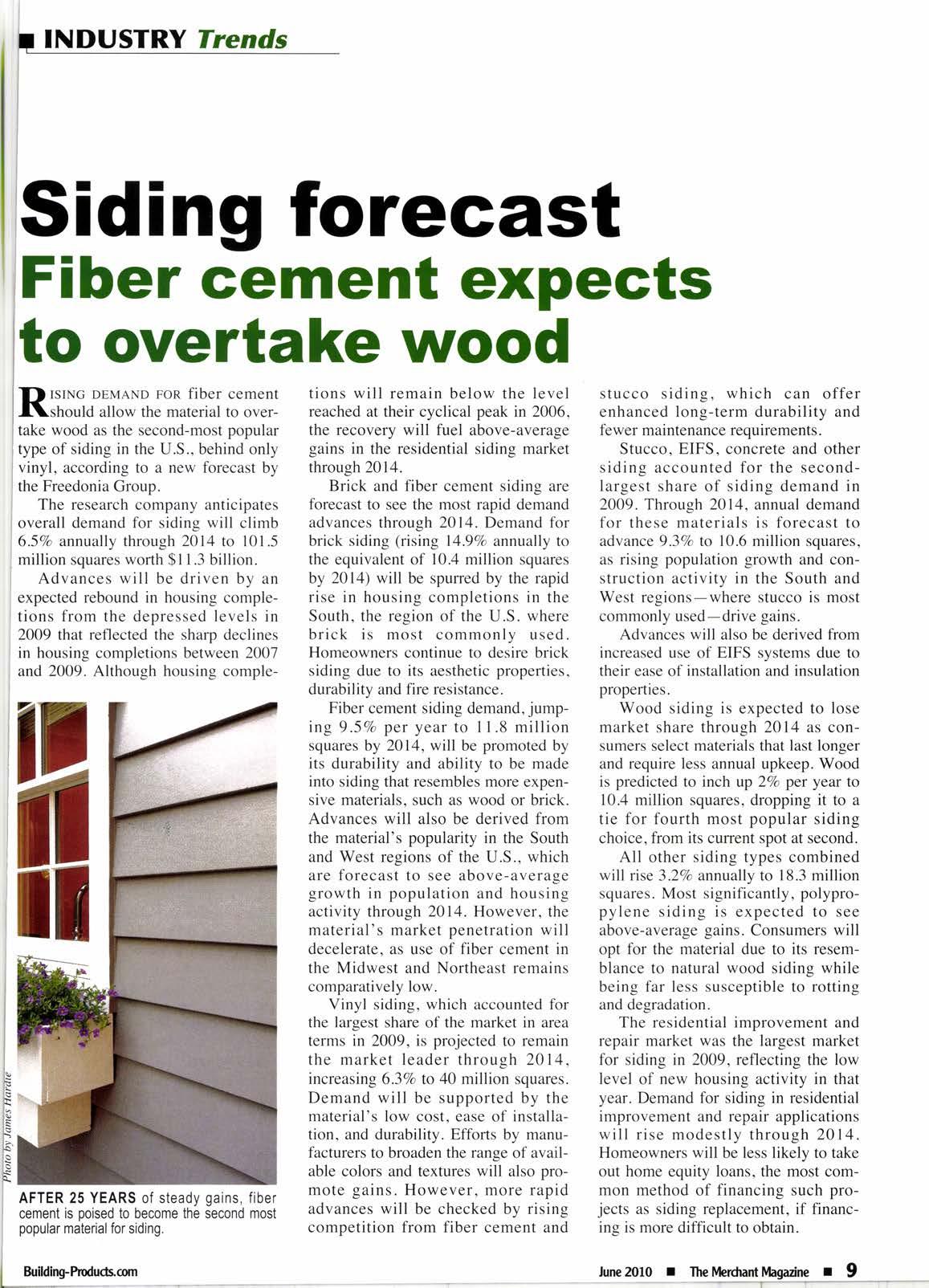
2 minute read
Siding forecast Fiber cement expects to overtake wood
D tstNc DEMAND ron fiber cement l\should allow the material to overtake wood as the second-most popular type of siding in the U.S., behind only vinyl, according to a new forecast by the Freedonia Group.
The research company anticipates overall demand for siding will climb 65Vo annually through 2014 to 101.5 million squares worth $ I 1.3 billion.
Advances will be driven by an expected rebound in housing completions from the depressed levels in 2009 that reflected the sharp declines in housing completions between 2007 and 2009. Although housing comple- tions will remain below the level reached at their cyclical peak in 2006, the recovery will fuel above-average gains in the residential siding market through 2014. hFiber cement siding demand, jurnping 9.SVo per year to 1 I .8 million squares by 2014, will be promoted by its durability and ability to be made into siding that resembles more expensive materials, such as wood or brick. Advances will also be derived from the material's popularity in the South and West regions of the U.S., which are forecast to see above-average growth in population and housing activity through 2014. However, the material's market penetration will decelerate, as use of fiber cement in the Midwest and Northeast remains comparatively low.
Brick and fiber cement siding are forecast to see the most rapid demand advances through 20 14. Demand for brick siding (rising 14.97o annually to the equivalent of 10.4 million squares by 2014) will be spurred by the rapid rise in housing completions in the South, the region of the U.S. where brick is most commonly used. Homeowners continue to desire brick siding due to its aesthetic properties. durability and fire resistance.
Vinyl siding, which accounted for the largest share of the market in area terms in 2009, is projected to remain the market leader through 2014, increasing 6.3V0 to 40 million squares. Demand will be supported by the material's low cost. ease of installation, and durability. Efforts by manufacturers to broaden the range of available colors and textures will also promote gains. However, more rapid advances will be checked by rising competition from fiber cement and stucco siding, which can offer enhanced long-term durability and fewer maintenance requirements.
Stucco, EIFS, concrete and other siding accounted for the secondlargest share of siding demand in 2009. Through 2014, annual demand for these materials is forecast to advance 9.37o to 10.6 million squares, as rising population growth and construction activity in the South and West regions-where stucco is most commonly used -drive gains.
Advances will also be derived from increased use of EIFS systems due to their ease of installation and insulation propertles.
Wood siding is expected to lose market share through 2Ol4 as consumers select materials that last longer and require less annual upkeep. Wood is predicted to inch tp 2Vo per year to 10.4 million squares, dropping it to a tie for fourth most popular siding choice, from its current spot at second.
All other siding types combined will rise 3.2Vo annually to 18.3 million squares. Most significantly, polypropylene siding is expected to see above-average gains. Consumers will opt for the material due to its resemblance to natural wood siding while being far less susceptible to rotting and degradation.
The residential improvement and repair market was the largest market for siding in 2009, reflecting the low level of new housing activity in that year. Demand for siding in residential improvement and repair applications will rise modestly through 2014. Homeowners will be less likely to take out home equity loans, the most common method of financing such projects as siding replacement, if financing is more difficult to obtain.










